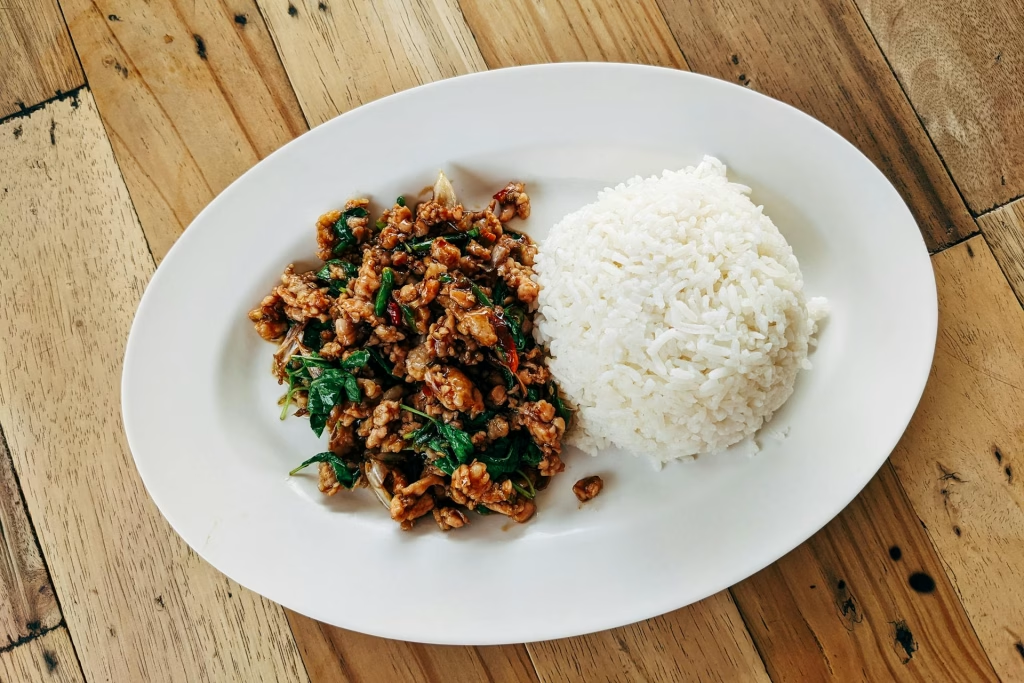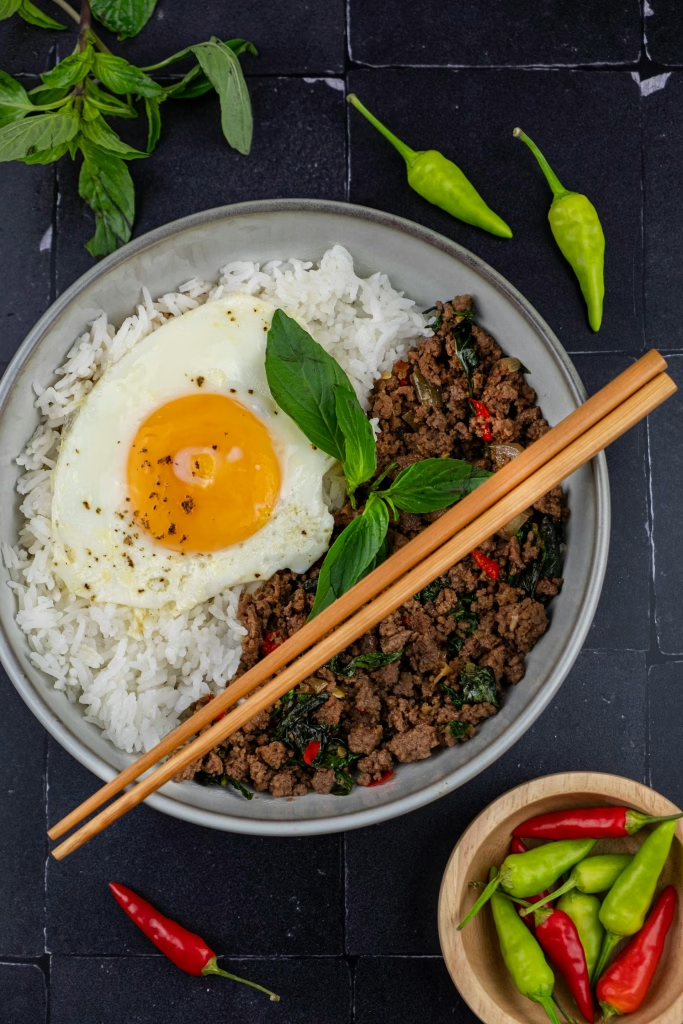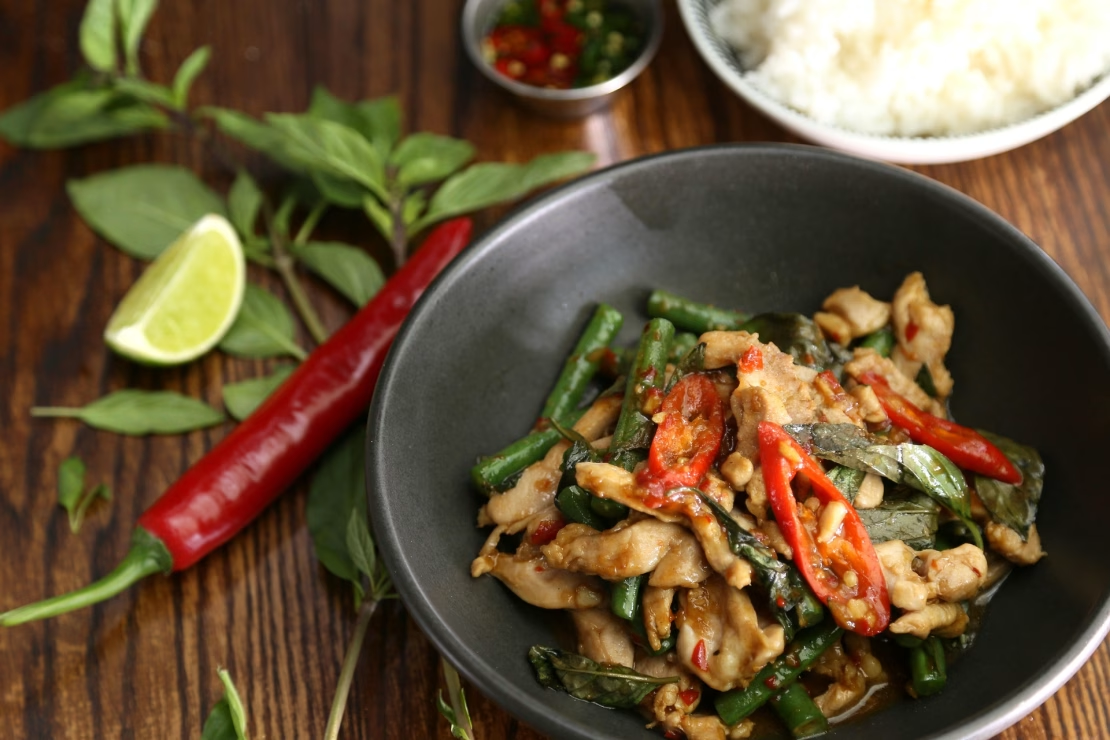Thai Basil Chicken, locally known as Pad Krapow Gai, is one of Thailand’s most iconic street food dishes.
Fragrant, spicy, and incredibly quick to prepare, this dish combines tender minced or finely chopped chicken with garlic, chilies, soy sauces, and the irreplaceable Thai holy basil. Served over steaming hot jasmine rice and often topped with a crispy fried egg, Pad Krapow Gai delivers an intense combination of flavors—savory, spicy, aromatic, and slightly sweet.
Whether you’re new to Thai cuisine or a seasoned lover of Southeast Asian flavors, this dish is an absolute must-try in your kitchen.
Table of Contents
Ingredients
For the Chicken Stir-Fry:
- 500g boneless skinless chicken thighs (finely chopped or ground)
- 1 cup fresh Thai holy basil leaves (bai krapow)
- 1 tablespoon vegetable oil
- 6 cloves garlic (finely chopped)
- 4-6 Thai bird’s eye chilies (adjust to taste, finely chopped)
- 1 small onion or 2 shallots (thinly sliced – optional)
- 1 tablespoon oyster sauce
- 1 tablespoon light soy sauce
- 1 teaspoon dark soy sauce (for color)
- 1 teaspoon fish sauce
- 1/2 teaspoon sugar
For Serving:
- Steamed jasmine rice
- Fried egg (optional but traditional)
- Lime wedges (optional)
Serves
Serves: 2–3 people
Preparation Time: 10 minutes
Cooking Time: 10–12 minutes
Total Time: 20–25 minutes
Step-by-Step Instructions
Step 1: Prepare Ingredients
Finely chop the chicken thighs or use pre-ground chicken. Wash and pluck the holy basil leaves. Mince garlic and chilies together using a knife or mortar and pestle.
Step 2: Make the Flavor Base
Heat oil in a wok or heavy skillet over medium-high heat. Add garlic and chilies and stir-fry for 20–30 seconds until fragrant, being careful not to burn them.
Step 3: Cook the Chicken
Add the chicken to the wok and stir constantly to break it into small pieces. Cook for 5–6 minutes or until the meat is no longer pink.
Step 4: Add the Sauces
Add oyster sauce, light soy sauce, dark soy sauce, fish sauce, and sugar. Stir to coat the chicken evenly. Cook for another 2 minutes, letting the sauce caramelize slightly and deepen in flavor.
Step 5: Add Basil Leaves
Turn off the heat and immediately toss in the holy basil. Stir vigorously until wilted—this preserves its flavor and aroma without overcooking.
Step 6: Serve Immediately
Spoon the Pad Krapow Gai over a bed of hot jasmine rice. Top with a crispy fried egg with runny yolk if desired. Serve with lime wedges or sliced cucumbers.

Serving Suggestions
- Classic Combo: Serve with a fried egg (kai dao) and steamed jasmine rice.
- Vegetable Side: Accompany with quick-pickled cucumbers or stir-fried greens like Chinese broccoli or bok choy.
- Drink Pairing: Thai iced tea or a crisp lager complements the heat and savoriness.
- Plating Tip: Mold rice in a small bowl, invert onto a plate, and top with stir-fry and egg for a street-style presentation.
Tips for Perfect Pad Krapow Gai
- Use Chicken Thighs: For authentic texture and juiciness, chopped chicken thighs are preferred over breast meat.
- Don’t Overcook Basil: Add holy basil at the very end and avoid prolonged cooking to preserve its fragrance.
- Use a Hot Wok: Stir-frying at high heat helps achieve smoky depth (wok hei).
- Adjust Heat Carefully: Thai bird’s eye chilies are hot. Use gloves when chopping and adjust to your spice tolerance.
- Balance Flavors: Taste test and tweak sauce ratios for your ideal salty-sweet-spicy balance.
Healthier Alternatives
- Use Lean Chicken Breast: Opt for leaner cuts or ground turkey for lower fat content.
- Less Oil: Reduce oil to 1/2 tablespoon and use a non-stick pan.
- Brown Rice or Quinoa: Replace jasmine rice with high-fiber options like brown rice or quinoa.
- Add Veggies: Add bell peppers, zucchini, or mushrooms for more fiber and volume.
- Use Low-Sodium Sauces: Choose reduced-sodium soy sauce and fish sauce to control salt intake.
Creative Variations
- Pad Krapow Moo (Pork): Substitute chicken with ground or sliced pork.
- Pad Krapow Tofu: Make it vegetarian by replacing meat with firm tofu or tempeh and omitting fish sauce.
- Seafood Version: Try shrimp or calamari for a coastal twist.
- Fusion Style: Serve on lettuce wraps, in a pita pocket, or as a topping for noodles.
- Pad Krapow Sliders: Use the chicken filling inside burger buns for a Thai street food slider.

Common Mistakes to Avoid
- Using Sweet Basil Instead of Holy Basil: Sweet basil lacks the intense peppery aroma crucial for authenticity.
- Overcrowding the Pan: Cook in batches if needed to avoid steaming the meat.
- Adding Basil Too Early: It becomes bitter and loses aroma when overcooked.
- Using Too Little Heat: Stir-frying requires high heat to bring out bold flavors.
- Skipping Fish Sauce: It provides depth and umami, even in small quantities.
History of Thai Basil Chicken (Pad Krapow Gai)
Pad Krapow Gai is deeply embedded in Thailand’s culinary landscape and culture. It reflects the essence of Thai street food—quick, bold, and satisfying. The dish became popular during the mid-20th century when stir-frying as a cooking method gained popularity in Southeast Asia due to Chinese culinary influence. Combining local ingredients like holy basil with Chinese techniques, Pad Krapow emerged as a fusion of Thai and Chinese food culture.
Over time, Pad Krapow Gai became a staple dish served in roadside stalls and family kitchens across the country. Its simplicity, speed, and flavor made it a go-to lunch for office workers, laborers, and food lovers alike. The addition of a crispy fried egg became a widespread custom, turning it into a complete and comforting meal. In modern Thailand, it’s one of the top 10 most-ordered dishes at any street vendor.
Today, Pad Krapow has transcended borders and is now a recognized Thai comfort food globally. From Bangkok to New York, chefs and home cooks recreate the dish using local ingredients, sometimes swapping holy basil for Italian basil and Thai chilies for jalapeños. Despite its variations, the soul of the dish—fragrant, fiery, and fast—remains intact.
FAQs about Thai Basil Chicken (Pad Krapow Gai)
1. Can I use sweet basil instead of holy basil?
You can, but holy basil is preferred for its unique spicy and peppery flavor. Sweet basil is milder and more floral.
2. What type of chicken is best?
Boneless skinless chicken thighs, finely chopped, offer the best flavor and texture.
3. How spicy is Pad Krapow Gai?
It can be very spicy if made traditionally. You can adjust the number of Thai chilies to reduce the heat.
4. Is this dish gluten-free?
It can be made gluten-free by using gluten-free soy sauce and oyster sauce alternatives.
5. Can I make it vegetarian or vegan?
Yes! Use tofu or tempeh and replace fish sauce with soy sauce or mushroom sauce.
6. What’s the difference between Pad Krapow and Pad Kee Mao?
Pad Krapow is a basil stir-fry over rice, while Pad Kee Mao is spicy basil stir-fried noodles (drunken noodles).
7. Can I freeze leftovers?
Yes. Store in an airtight container for up to 2 months. Reheat gently to preserve flavor.
8. What’s the best way to reheat it?
Use a hot skillet or microwave with a splash of water to keep the chicken moist.
9. Why is my basil turning black?
Overcooking or refrigerating holy basil can cause it to turn black. Add it just before serving.
10. Can I use pre-ground chicken from the store?
Yes, but finely chopped chicken gives better texture and allows flavor to absorb more evenly.
Thai Basil Chicken (Pad Krapow Gai) is a quick, fiery, and deeply satisfying dish that represents the heartbeat of Thai street food. With just a few ingredients and simple techniques, you can recreate this bold and authentic flavor right in your kitchen. Whether served with a crispy fried egg, adapted to your health needs, or spiced to your tolerance, Pad Krapow Gai is versatile, deeply aromatic, and sure to become a repeat favorite. It’s a celebration of balance, heat, and herbaceous depth—just like Thailand itself.


